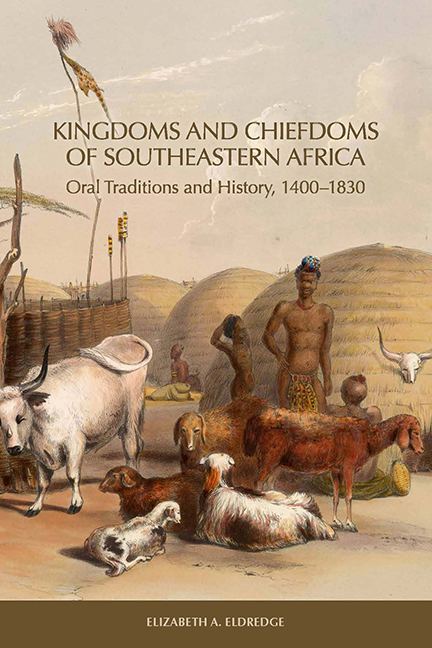Book contents
- Frontmatter
- Contents
- List of Illustrations
- Preface
- 1 History and Oral Traditions in Southeastern Africa
- 2 Oral Traditions in the Reconstruction of Southern African History
- 3 Shipwreck Survivor Accounts from the Sixteenth and Seventeenth Centuries
- 4 Founding Families and Chiefdoms East of the Drakensberg
- 5 Maputo Bay Peoples and Chiefdoms before 1740
- 6 Maputo Bay, 1740–1820
- 7 Eastern Chiefdoms of Southern Africa, 1740–1815
- 8 Zulu Conquests and the Consolidation of Power, 1815–21
- 9 Military Campaigns, Migrations, and Political Reconfiguration
- 10 Ancestors, Descent Lines, and Chiefdoms West of the Drakensberg before 1820
- 11 The Caledon River Valley and the BaSotho of Moshoeshoe, 1821–33
- 12 The Expansion of the European Presence at Maputo Bay, 1821–33
- 13 Southern African Kingdoms on the Eve of Colonization
- Appendix A Ama Swazi King Lists
- Appendix B Chronology of Conflicts, Migrations, and Political Reconfiguration East of the Drakensberg in the Era of Shaka
- Appendix C Interviewees from the James Stuart Collection of Oral Traditions
- Notes
- Bibliography
- Index
9 - Military Campaigns, Migrations, and Political Reconfiguration
Published online by Cambridge University Press: 14 March 2018
- Frontmatter
- Contents
- List of Illustrations
- Preface
- 1 History and Oral Traditions in Southeastern Africa
- 2 Oral Traditions in the Reconstruction of Southern African History
- 3 Shipwreck Survivor Accounts from the Sixteenth and Seventeenth Centuries
- 4 Founding Families and Chiefdoms East of the Drakensberg
- 5 Maputo Bay Peoples and Chiefdoms before 1740
- 6 Maputo Bay, 1740–1820
- 7 Eastern Chiefdoms of Southern Africa, 1740–1815
- 8 Zulu Conquests and the Consolidation of Power, 1815–21
- 9 Military Campaigns, Migrations, and Political Reconfiguration
- 10 Ancestors, Descent Lines, and Chiefdoms West of the Drakensberg before 1820
- 11 The Caledon River Valley and the BaSotho of Moshoeshoe, 1821–33
- 12 The Expansion of the European Presence at Maputo Bay, 1821–33
- 13 Southern African Kingdoms on the Eve of Colonization
- Appendix A Ama Swazi King Lists
- Appendix B Chronology of Conflicts, Migrations, and Political Reconfiguration East of the Drakensberg in the Era of Shaka
- Appendix C Interviewees from the James Stuart Collection of Oral Traditions
- Notes
- Bibliography
- Index
Summary
Shaka faced numerous challenges to his campaign of AmaZulu expansion following the death of Dingiswayo and his incorporation of the remnants of the AmaMthethwa chiefdom. In the north the greatest threat came from the AmaNdwandwe under Chief Zwide because the larger Ama- Hlubi chiefdom had never been militarized and was weakened following the death of Chief Bhungane in about 1815. The AmaKhumalo segment led by Mzilikazi rose in rebellion to Shaka's assertion of authority, and the Ama Ngwane under Chief Matiwane attacked the Ama Hlubi before themselves coming under attack and being forced to fLee by Shaka's forces. To the south the AmaCele and AmaThuli conceded to Shaka's show of force and AmaZulu rule, and their chiefs became tributary subordinates to Shaka, but Shaka sent troops south of the Thukela to raid throughout the region and enrich his herds with captured cattle. Ultimately, Shaka decided that the AmaMpondo under Chief Faku were a threat and sent two military campaigns against them as he considered expansionism to the south. In the meantime, however, far to the north the kingdom of the Ama Swazi was emerging under the leadership of Shaka's contemporary, Somhlolo, who as Sobhuza I became known as the founder of the Ama- Ngwane Swazi kingdom.
Chief Zwide and the AmaNdwandwe
Zwide built the AmaNdwandwe into a powerful chiefdom by means of both treachery and military aggression against his neighbors. The Swazi royal Giba ka Sobuza told Stuart in 1898 how Zwide drove the emerging Ama- Swazi kingdom of Somhlolo (later known as Sobhuza) from their homes at Etshiselweni:
Here they lived until attacked by Zwide, the Zulu chieftain, in Tshaka's reign. The Swazis were defeated by Zwide and put to fLight. They fLed into what is now the Transvaal, to the Basutos [Transvaal Sotho]. Ncaba, Zwangendaba and Mpakeni fLed at the same time. Sobuza's kraals were burnt by Zwide and the place is now known by the name Etshiselweni. There is a Zombode kraal at Etshiselweni, the present induna being the man Silele above referred to. The Swazis fLed as far as the Basutos, to Esidhlomodhlomo hill, because Zwide's impi followed them.
- Type
- Chapter
- Information
- Kingdoms and Chiefdoms of Southeastern AfricaOral Traditions and History, 1400–1830, pp. 207 - 236Publisher: Boydell & BrewerPrint publication year: 2015

